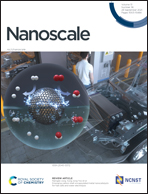Tuning the electro-optical properties of nanowire networks†
Abstract
Conductive and transparent metallic nanowire networks are regarded as promising alternatives to Indium–Tin–Oxides (ITOs) in emerging flexible next-generation technologies due to their prominent optoelectronic properties and low-cost fabrication. The performance of such systems closely relies on many geometrical, physical, and intrinsic properties of the nanowire materials as well as the device-layout. A comprehensive computational study is essential to model and quantify the device's optical and electrical responses prior to fabrication. Here, we present a computational toolkit that exploits the electro-optical specifications of distinct device-layouts, namely standard random nanowire network and transparent mesh pattern structures. The target materials for transparent conducting electrodes of this study are aluminium, gold, copper, and silver nanowires. We have examined a variety of tunable parameters including network area fraction, length to diameter aspect ratio, and nanowires angular orientations under different device designs. Moreover, the optical extinction efficiency factors of each material are estimated by two approaches: Mie light scattering theory and finite element method (FEM) algorithm implemented in COMSOL®Multiphysics software. We studied various nanowire network structures and calculated their respective figures of merit (optical transmittance versus sheet resistance) from which insights on the design of next-generation transparent conductor devices can be inferred.



 Please wait while we load your content...
Please wait while we load your content...